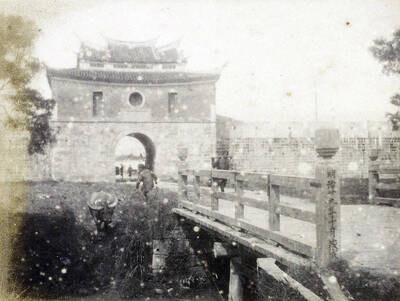Taiwan has one of the highest Internet usage rates in the world with 13.8 million
users. Roughly 58 percent of the population of 22.8 million is able to
access the Internet from home. But for the visually impaired the statistics are very different. Of the nation's 50,000 blind residents less than 5 percent have regular access to
computers.
While it might seem that the nation's blind population has a raw deal when it comes to Internet access, technological breakthroughs over the past five years have in fact enabled more blind people in Taiwan to interact in cyberspace than ever before.
In 2000 an estimated 600 people had access to screen-readers, or machines that enable the blind to enter and read text via a Braille finger pad. Since then this figure has doubled and now between 1,200 and 1,500 visually impaired citizens have access to computers and the Internet thanks to Tamkang University's Resource Center for the Visually Impaired (RCVI, 盲生資源中心).
"The numbers may be still be small, but without the work of the center they'd be even smaller," said Yang Sheng-hong (楊聖弘), secretary general of the Technology Development Association for the Disabled in Taiwan (TDADT,
"Before the center began its work Taiwan's blind had little or no opportunity to access information or use computers on an everyday basis."
Established in 1989, the RCVI is the nation's leading research center geared toward the development of new computer technology to suit the needs of the blind. Jointly funded by Tamkang University, the Ministry of Education and the Ministry of the Interior, and with technical support provided by China Telecom, the center is considered by many as a vanguard movement for the improvement of the lot of the nation's blind.
The center first developed basic DOS-based equipment in the mid-1990s, but it wasn't until 2002 that equipment first began to make a real difference to lives of the blind following the release of the nation's first affordable Microsoft Windows-based Braille screen-reader.
The brown metal box, which measures 35cm by 20cm, has 45 touch Braille pads and employs a synthesized voice, which can be set to converse in either Mandarin or English. It reads items on the screen, describes graphics and states the user's keyboard commands. Costing around NT$50,000, the nation's first indigenous
Windows based screen-reader was dubbed "Super Braille."
Before its release the only suitable Windows compatible systems had to be imported form the US or Europe and cost around NT$100,000.
"It took longer to develop than initially thought, but since its release three years ago the Super Braille Windows system has become a fixture in both homes and work places," said the center's Lai Chun-chi (賴俊吉). "We managed to slash the costs of screen-readers and at the same time enable blind people to use Windows 98, 2000, and more recently XP. This is something that as recently as five years ago we never thought possible."
Although Lai modestly downplays the difficulties experienced by the center during the development of Super Braille, the work of the screen-reader is in fact quite complex. The Super Braille system is tasked with reading both links scattered on a page as well as any and all information arranged in tables. It has to differentiate between Web pages arranged in columns and those laid out in the more standard form of left to right.
The machine has changed the lives of people like Fang Yu-chi (
"The Windows based system is fantastic. I first used a screen-reader eight years and, while enabling me to work and access the Internet it was DOS version and there were a lot of restrictions as to what I could and couldn't do," she said. "With Windows it means that I can do all the same tasks in an office environment that a sighted person can do."
The release of the machine has meant that several leading non-governmental organizations, once highly critical of the way in which successive governments dismissed the need to promote information and network literacy programs for the blind, have now altered their once pessimistic views.
"Government agencies and social welfare groups have changed the way in which they think. Before it was thought the only job a blind person could get was in the massage industry," said Liu Chun-hong (劉俊宏) of the Taiwan Institute for the Blind (台灣盲人重建院). "You didn't need much of an education and costs were low. Super Braille has changed all this and now there are more computer literacy classes for the blind than ever before and we have the opportunity to take office jobs once deemed unsuitable for blind people."
Due to equal opportunities programs that now exist at all levels in both the governmental and the private sector, companies are now more willing to hire visually impaired personnel and provide them with the specialist equipment needed.
"Without the release of [Super Braille] and the local government's reimbursement program I would never have been able to learn how to use a computer," said Shyh An-yu (石安玉). "Now I'm able to work in the office and at home, use MSN and Skype to chat with my friends."
The increased usage of RSVI's screen-reader has in turn led to a marked rise in the number of Web sites designed specifically for the blind. There are now 30 Web sites nationwide aimed at improving the lives of the blind, offering everything from advice on social welfare issues to English language instruction.
"The number of Web sites has increased 10-fold over the past couple of years and we hope to see a greater increase as more blind people are made aware of the huge amount of resources available to them on the Internet," Yang said. "We hope that by the end of next year that there will be at least 100 sites in Taiwan."
The largest and most popular of the Web sites designed specifically for the blind is hosted by the RCVI. As well as developing the nation's first affordable screen-reader, the center's on-line database is the nation's largest.
The electronic Braille online library boasts a staggering 2,000 titles in both English and Chinese. It includes everything from popular fiction like the Harry Potter titles to tomes such as A Short History of Western Civilization, as well as large numbers of Chinese language novels and works of non-fiction.
The Web site also enables those with access to the center's Super Braille system to read monthly periodicals, including the popular English language tuition publication Studio Classroom and the weekly magazine dedicated to the world of commerce, Business Weekly (商業周).
Braille newspapers are also available and in a joint venture with the China Times (
Since it went on-line three years ago the RCVI's Web site has received thousands of hits. On any given month it receives upwards of 82,000 hits from blind people nationwide. Its library continues to grow on a weekly basis as more and more texts, tomes and titles are added to its already extensive catalogue.
"We just received our first Braille compatible scanner which allows us to scan text and the computer system automatically transcribes it into Braille," Lai said. "This will speed the input of data and means that one day in the near future Taiwan's blind will be able to access any periodical, novel or newspaper they want to at the touch of a button."

June 9 to June 15 A photo of two men riding trendy high-wheel Penny-Farthing bicycles past a Qing Dynasty gate aptly captures the essence of Taipei in 1897 — a newly colonized city on the cusp of great change. The Japanese began making significant modifications to the cityscape in 1899, tearing down Qing-era structures, widening boulevards and installing Western-style infrastructure and buildings. The photographer, Minosuke Imamura, only spent a year in Taiwan as a cartographer for the governor-general’s office, but he left behind a treasure trove of 130 images showing life at the onset of Japanese rule, spanning July 1897 to

In an interview posted online by United Daily News (UDN) on May 26, current Chinese Nationalist Party (KMT) Chairman Eric Chu (朱立倫) was asked about Taichung Mayor Lu Shiow-yen (盧秀燕) replacing him as party chair. Though not yet officially running, by the customs of Taiwan politics, Lu has been signalling she is both running for party chair and to be the party’s 2028 presidential candidate. She told an international media outlet that she was considering a run. She also gave a speech in Keelung on national priorities and foreign affairs. For details, see the May 23 edition of this column,

The Taiwan People’s Party (TPP) on May 18 held a rally in Taichung to mark the anniversary of President William Lai’s (賴清德) inauguration on May 20. The title of the rally could be loosely translated to “May 18 recall fraudulent goods” (518退貨ㄌㄨㄚˋ!). Unlike in English, where the terms are the same, “recall” (退貨) in this context refers to product recalls due to damaged, defective or fraudulent merchandise, not the political recalls (罷免) currently dominating the headlines. I attended the rally to determine if the impression was correct that the TPP under party Chairman Huang Kuo-Chang (黃國昌) had little of a

At Computex 2025, Nvidia CEO Jensen Huang (黃仁勳) urged the government to subsidize AI. “All schools in Taiwan must integrate AI into their curricula,” he declared. A few months earlier, he said, “If I were a student today, I’d immediately start using tools like ChatGPT, Gemini Pro and Grok to learn, write and accelerate my thinking.” Huang sees the AI-bullet train leaving the station. And as one of its drivers, he’s worried about youth not getting on board — bad for their careers, and bad for his workforce. As a semiconductor supply-chain powerhouse and AI hub wannabe, Taiwan is seeing